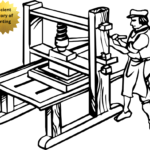Compose is the term used in the printing industry to describe the process of positioning text and images on a page so that they are ready for printing. This involves selecting typefaces, sizes, and layouts to ensure the finished print is both readable and aesthetically pleasing. In the past, type was set by hand; however, digital typesetting software is now the primary method used.
Types of Composing:
We see different types of composing. For example:
1. Hand composing;
2. Monotype composing;
3. Linotype composing;
4. Photo typesetting;
5. Computer composing

Hand Composing:
The oldest composing in the world is hand composing. In this method, letters are arranged one by one by hand. The person who does this work is called a compositor. Letters are taken from separate blocks and arranged in the right place with the help of brass or iron sticks. After preparing the matter, it is printed on the press. In this case, the compositor has to do the whole work with great skill. This is, of course, a difficult job.
In this method, a compositor can arrange about 200 words per hour. The disadvantage in this case is that the letters break due to repeated use, and the printing is not very good. At present, the use of hand composing is almost non-existent.
Lino Composing:
One type of advanced mechanical composing is lino composing. This mechanical method was inaugurated in 1886 by Otmar Mergenthaler of the United States. Earlier, the typewriter was invented in 1867. Many people believe that this method was invented based on the concept or formula of the typewriter. In this method, composing is done on a machine. When you press the keyboard on the lino machine, an impression of the letters comes out. Then the heated lead melts and is cast into a mold, creating a tight. In this lino method, new types are always arranged, so the printing is done on a shiny board. This speeds up printing by hand-composing. Therefore, experts believe that this method is better than hand and monocomposing methods, but this method is not used much at present.
Phototype Setting:
After Lino Composing, the phototype setting method was introduced. It was the most popular method at that time. In this method, instead of hot lead or metal, the letters are displayed on the screen or screen through cathode rays with the help of electricity. In this, the photo of the negative is taken on a special type of coated sensitive photography paper with the help of electronic photography. Then the plate is made by making a positive of the composed matter of the offset camera. This plate is used for printing. This method allows for corrections and also prints on glossy plates. It was quite popular and was used in large quantities. However, the disadvantage was that this method was very expensive. Therefore, its popularity did not last long.
Computer Composing:
Currently, computer composing is the latest technology in this modern world. This computer-based publishing method is called desktop publishing. It is now possible to compose, place images, scan images, correct, change, enlarge, make positives, etc., on computers. In this method, text and images are input using a keyboard, scanner, digital camera, magnetic drive, optical drive, etc. After inputting, necessary corrections, changes, refinements, subtractions, arrangements, formatting, etc. are done on the monitor screen, and then the print is taken. When the material is finalized, a tracing print is taken. Then the plate is made and printed.
Computer data is stored as digital data. This computer-based desktop publishing is a revolution in the printing industry. The advantages of computer-based composing are:
1. There are unlimited possibilities.
2. The printable matter is stored as digital data;
3. Formatting can be done easily, in less time and as desired;
4. Changes, enhancements, refinements, and deletions can be done easily;
5. Images can be added as desired;
6. Color printing can be done;
7. Printing can be done on tracing paper;
8. More work can be done in less time;
9. Composition can be done accurately;
10. The quality of the print is improved and enriched.
Computer-based composing has gained a lot of popularity due to its various advantages. As the amount of computer memory has gradually increased, its size, price, and weight have also decreased. It is not only convenient in use but also easy to use. In addition, the introduction of the latest color processing methods, including graphics, has brought a lot of convenience to the printing world and increased its aesthetics. Therefore, its popularity is constantly increasing.
At the beginning of the printing industry, sentences were made by arranging metal letters one by one by hand. Then they were printed. But nowadays, hand composition is not used much. Even lino machines, mono machines, or phototype settings are not used much. A huge area of composition has been occupied by the latest information technology programs, i.e., computer composition. All pre-printing work is now completed through technology. This has brought speed to printing work. As speed has come, so has precision, and the number of mistakes has also decreased. However, experts believe that this has increased the number of copyright violations. This is definitely due to a kind of dishonest business practice, so technological excellence cannot be stopped. We have to move forward. The printing industry needs to expand and develop further.



